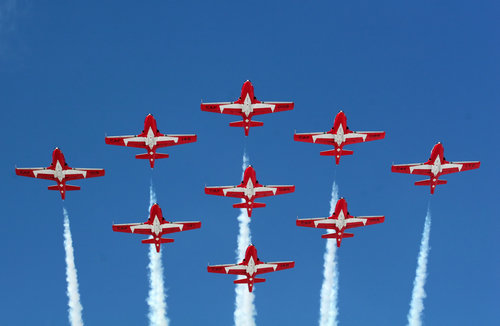As the legal battle over the fate of Vice Admiral Mark Norman was being played out in an Ottawa court Wednesday just a short distance away in the House of Commons the country’s political leaders were dealing with a related issue.
| MV Asterix, accompanying Royal Canadian Navy ships, replenished two US Navy vessels at the same time in the North Atlantic this week. The USN ships are USS Bainbridge and USS Mitscher. March 2018 |
Norman is charged with one count of breach of trust for allegedly providing information to Davie Shipbuilding which had entered into a deal with the previous Conservative government to provide a supply ship to the Royal Canadian Navy.
Conservative leader Andrew Scheer questioned the Liberal government why it was not moving ahead with having Davie provide a second supply ship – the Obelix – to the navy. Scheer said the navy needed the second ship. “The Prime Minister has to stop playing political games and before Christmas should award that contract to Davie,” he told the Commons. “What’s he waiting for?”
But Trudeau accused Scheer of playing “petty politics.”
“The armed forces did an assessment,” Trudeau explained. “They don’t need the Obelix and for him to suggest that we should buy it anyway is pure base politics, the worst politics. We make our decisions based on facts. We recognize the quality of work done by Davie shipyard and we do want them to get good jobs but we are not going to make up work for political reasons.” Trudeau's comments follow the same line as comments made by Minister of Transportation Marc Garneau in December of 2017.
Conservative leader Andrew Scheer questioned the Liberal government why it was not moving ahead with having Davie provide a second supply ship – the Obelix – to the navy. Scheer said the navy needed the second ship. “The Prime Minister has to stop playing political games and before Christmas should award that contract to Davie,” he told the Commons. “What’s he waiting for?”
But Trudeau accused Scheer of playing “petty politics.”
“The armed forces did an assessment,” Trudeau explained. “They don’t need the Obelix and for him to suggest that we should buy it anyway is pure base politics, the worst politics. We make our decisions based on facts. We recognize the quality of work done by Davie shipyard and we do want them to get good jobs but we are not going to make up work for political reasons.” Trudeau's comments follow the same line as comments made by Minister of Transportation Marc Garneau in December of 2017.
Reports from the Royal Canadian Navy indicate that there is a need for a second supply ship on the West Coast - but for now, the Asterix will be shared between both coasts until the new Protecteur-Class AORs are built by Seaspan and in service around 2026.
 |
| M/V A.Obelix is a container ship which is available for immediate purchase and conversion into a second interim-auxiliary oil replenishment ship for the Royal Canadian Navy. Davie Shipbuilding and Federal Fleet Services is offering this to the Government of Canada, and says it could have the Obleix operational as an iAOR by early 2020; six years before the Protecteur-Class AORs are available. |







/https://www.thestar.com/content/dam/thestar/politics/federal/2018/11/24/fighter-jet-delays-fuelling-exodus-of-pilots-from-air-force-insiders-say/cf_18.jpg)





